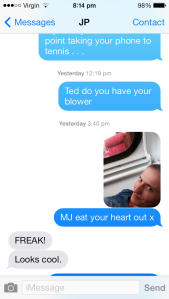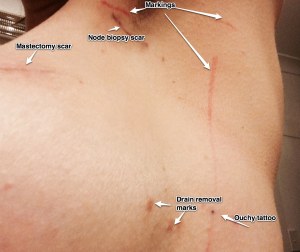Making major health decisions is a tricky business. Particularly when you are hell bent on pushing up against experts and challenging norms. The choice to have radiotherapy was perhaps the hardest of all, and as the start date looms, I’m finding I need to really work to keep my nerve. The pamphleture is not helpful here. When describing the process it states that after you are set up on the machine “The medical staff leave the bunker and survey you via camera.” The bunker? Surveillance? Hell’s bells. I’m expecting tears in my ears again.
Recently I’ve found myself party to a number of claims which, pre diagnosis, would have washed over me. Low magnesium causes cancer. Vegans don’t get cancer (*looks skyward* is that right, Steve Jobs?). Stress causes cancer. Let me tell you why I got cancer. My mother, the person who, ya know, made me and all, had a gene that instructed her tits to kill her. And I inherited that gene. I’ve not been tested, but I know it’s true. It’s a total non-mystery. Perhaps it’s the case that genes load the gun and environment pulls the trigger. Having three young kids is quite stressful. But what sort of mentalist goes around wishing their greatest source of joy didn’t exist? Exactly.
Hot on the heels of the ‘why you get it’ claims are the ‘how to fix it’ claims. The most unpalatable I’ve seen is via a Facebook photo with a message that ‘traditional cancer treatments don’t work/are carcinogens and are perpetuated because it suits Big Pharma’. This kind of stuff is SO EASY to say and consume if you’ve not got it. If you have, it’s emotional TNT. I’m pretty open about this experience, but that shit sticks in my craw, my friend. You’ll probably remember sprouted bread‘s claim that oxygen therapy “kills cancer cells and stuff like that.” Wound me up no end.
I am all for questioning conventional wisdom, but in the words of Tim Minchin:
Alternative Medicine…
Has either not been proved to work,
Or been proved not to work.
You know what they call alternative medicine
That’s been proved to work?
Medicine.
It’s complex, though, because no sooner do I get all stabby about it than I seek it out. Oxygen therapy is an alternative (or more accurately, complimentary) treatment that is backed up by successful scholarly reviews which prove it expedites the healing of damaged skin and tissue, hence its use amongst professional athletes. Even reviews that apply gushing testimony like ‘it’s a cure waiting for a disease’ dismiss the cancer claim, or hedge their bets with the ‘not enough evidence’ argument.
On the verge of booking up a series of sessions in the oxygen tank (and dropping more than $1,000 in the process) I tried to find out more as to when it is best administered to prevent the common side effect of radiotherapy on women with implants, namely capsular contracture (basically too much scar tissue). I was going to do the treatment on the same days as the radiotherapy, but then read that’s not advisable. Some reports say to do it before. Others after. Others say because it can take months for the scar tissue to build up, you should wait till the damage starts to show itself, then have the oxygen therapy. I was confused, confounded and with radiotherapy starting on 4 November, running out of time to decide. I told my psych “I feel very alone trying to work all this out. I wish someone would take my case on and tell me the best thing to do.”
He pounced on this. “Like a mother figure?” “YES!” I cried. Cue furious note-taking. But on reflection if mum were here we’d probably be arguing about what to do. Arguing was our specialty. I’d doubtless be moaning about her muddying the waters.
As it is I’ve chosen to hedge my bets and do a series of oxygen treatments before and some soon after radiotherapy finishes. Embarrassingly, I’ve chosen this strategy based on a totally random doctor’s recommendation. He’s called Boris and probably got his doctorate online. I can’t find any of the ‘UK protocols’ he cites. So maybe I’m nuts. But it’s obvious by now that no-one actually knows what’s best, let alone when’s best, so I’ll just empty my wallet and cross my fingers.
Once I had made an uneasy peace with that decision I started to feel less daunted about the radiotherapy itself. I also enjoyed the first session in the oxygen tank, where I read a book and had a doze and arrived home to have Ted tell me my skin looked revived. Did it? Who knows. My usual 4pm dip in energy didn’t happen, but that was probably because of the nap rather than the oxygen.

So I was feeling pretty okay up until this afternoon, when I got a phone call from the radiotherapist to tell me that to effectively administer the radiotherapy, I’m going to have to have my right foob deflated. To the accompaniment, I imagine, of a descending penny whistle. I’ve had to get a rush appointment at the plastic surgeon to have this done. Ain’t that a hole in the bowl?
Over the weeks to come, I’ll be reconfronted by the awfulness of everything. A reddening, flaking tortoise shell of an implant on the treated left side and a fuck-knows what on the other. My clothes won’t fit.
As I type I realise the break I’ve had was just that, a break. I have to absorb all the oxygen I can and then I’ll have to go deep to get through this.
And now I have to stop, because … you can guess the rest.


